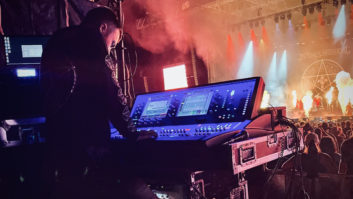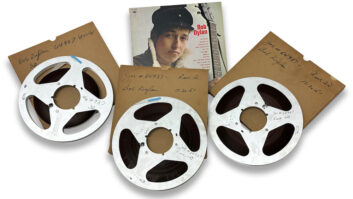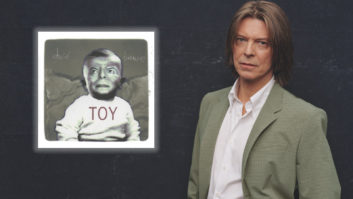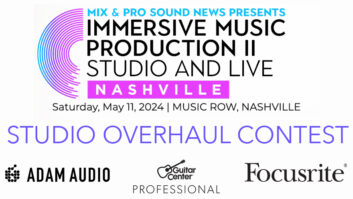Musician and songwriter Marvin Etzioni brings his passion for music and his own artistic sensibilities to all of his production work. As a result, he has avoided the trappings of the glossy pop producer and chosen to work with singer/songwriters who create organic, roots-oriented music.
A 20-year veteran of the music business, Etzioni began his career playing mandolin and guitar. He flirted with the big time when his early-’80s band, The Model, got the chance to work with Bruce Springsteen producer Chuck Plotkin. Although no recorded material came out of the sessions, Etzioni gained valuable experience for his next project, which initially entailed producing and helping arrange songs for Lone Justice. After that group’s bassist quit, Etzioni learned to play the instrument so that he could tour with them and record their self-titled Geffen debut with Jimmy Iovine producing. Following the record’s release, the band toured further, opening for the likes of U2 and Tom Petty. Though things were looking up for Lone Justice, Etzioni left before their second album was recorded to pursue other creative interests.
Etzioni then worked on solo projects as Marvin (albums included The Mandolin Man, Bone and Weapons of the Spirit) and produced and collaborated on songs with other singer/songwriters, including Victoria Williams, former Lone Justice singer Maria McKee, Voice of the Beehive and Susanna Hoffs (whose sessions remain unreleased). He has also co-produced the Williams Brothers album Harmony Hotel, produced the song “Miller’s Angels” for Counting Crows, the album Pale and the song “Brother” for Toad the Wet Sprocket, and Tom Freund’s debut record, North American Long Weekend. He recently co-produced the Lone Justice compilation The World Is Not My Home. Etzioni also has two new solo albums in the works, and albums he produced for Jeremy Toback on RCA and Peter Case on Vanguard are due out soon.
Throughout his career, the song has always been most important to Etzioni. While so many major labels seem to put out homogenous pop, actually striving to make records that sound alike, Etzioni stands out as a producer who cares about maintaining artists’ integrity and creative control.
Aside from your work with Lone Justice, you’ve released three solo albums that you sing and play on. How do you make use of that experience when you work with other singer/songwriters?
Songs have always been the center for me. The way that I hooked up with Ryan and Maria [from Lone Justice] is because I had already gone through the circle of being in a band, working with a major producer, and while that story didn’t go to completion, I just continued playing clubs. I was active, and I was doing it. So I think artists feel comfortable with that knowledge that I have of songs, because they know I’m coming from an inside place about it.
It’s not grandstanding. I understand the process, and I can help with it or encourage it. I think it’s what connected Adam Duritz and myself, other records I’ve done or even the sound of my own solo records. Even though I never worked with Jakob Dylan, we have the same connection. In consideration for working with him, we had talked, and he was a fan of the Mandolin Man album. I think that, at least for me, having that as a center draws outside artists to feel like, “Okay, he really does know what I’m going through and really does know what I’m talking about here.”
With some of the people you’ve produced-the Williams Brothers, Counting Crows, Maria McKee-you have co-written songs with them. Is that something you planned, or is that something that occurred during the actual recording process?
Each project is different. With the Counting Crows, I had met Adam and the band prior to the first album in consideration for producing it. Obviously T-Bone [Burnett] did that, but after that record had hit, Adam called and said, “Look, I’ve got a couple of songs. Would you consider producing them?” I said to send them over. I just gave them a very frank response. I told him the first song was good but I didn’t hear his soul in it, and the second song I thought was great. He kind of laughed and said, “I didn’t write the first song.” He wanted to focus in on the second. Then I said, “I really want to work with the band. I don’t really want to do an Adam Duritz solo project with just you on piano. I feel that we can make a really stunning rendition of this song with your band.” He said, “You know, you’re the only guy that’s really talked about it that way.” I was really up for the challenge of working with the band because I know how to do that. I know how to take the bare bones of a song and work with a band and find it.
Working with Maria was different. We hadn’t worked together since the first Lone Justice album, and I originally came in to do some co-writing with her on her second solo album, and that was it. We had worked on a few songs, and the producer and Geffen liked them. Then I went on tour opening up for Toad, and she said, “Aren’t you going to go into the studio and record them with me?” I didn’t know I was supposed to. I said, “I tell you what: Let me do this tour, and after I come back, if you want to record together, great.” I didn’t even know that was our intention, but it just kind of evolved into it.
How do you think a band like Lone Justice would fare today?
I think really well.
Do you think the climate’s better now for that kind of music?
It’s completely wide open right now. That [first] album’s a contemporary record. I think that the sound we were evolving in late ’82 to ’83 is pretty much reflective of what’s happening right now. Although I’m not quite sure if I was to do it right now if I would approach it that way. I’d want to do something that is as ground-breaking now as that was then. I would probably try to come up with a brand-new hybrid rather than The Clash and Hank Williams or Stones and George Jones kind of trip.
Maybe now I’d incorporate some other elements. I’m not sure what-beat box elements or just something that creates a new hybrid that hasn’t been seen, heard or felt before. But it would still be in a song-oriented vein. The reason I think that the early stuff works is because no matter how you “hybrid” something, as long as the song is strong it doesn’t matter. To me, what you have around it is supportive of the tune. A lot of times, you have a style but you don’t have a particular substance, and then you listen back to those records and go, “This is smoke and mirrors.” But if you have a tune, you can really put it in various points of view, and I think that’s why the early Justice stuff would be contemporary, because the songs sing. I think that there’s something to that.
What was it like producing yourself on your solo records?
It was interesting because I tried to come up with a point of view that fit the sound in my head. Every once in a while I would hit it. [Laughs.] I think my favorite stuff that I cut on my own I cut with a P.A. system, so that opened things up. We were actually getting the vocals coming through the drum mics, so it’s a little bit thicker of a sound. With all I’ve done, I’ve experimented and tried other things-even more traditional kinds of recordings-and that seems to have been my favorite sound.
So you like recording live in the studio rather than building up off of the rhythm section like many other producers do?
I don’t like that; I like things that happen in a moment in time. On the entire Toad album I produced, every vocal is cut live. Glen even tried to redo a vocal, and he couldn’t beat it. Same thing with Tom’s record. We added things on top-meaning there was a vocal and a guitar or a vocal and a drum or vocal, stand-up bass and drums-but I always had that as the core happening simultaneously.
So, did you have a vocal to a click track or a vocal with other instruments?
It all depends. I don’t like using clicks. I don’t really mind things having a real heartbeat of their own. Aretha Franklin records actually rush; it’s a natural adrenaline that goes through everyone’s system at the same time. You couldn’t put a click to that. It wouldn’t match up.
Obviously, musicians may speed up or slow down.
Exactly.
Which makes it harder if you take the traditional bass-and-drums-first approach.
I think one of the problems with that is that you’re not centering the experience around the song, and you’re getting it out-of-time. Meaning that the time experience is no longer about the singer, that it’s really about making the record. I see myself more as someone who produces artists rather than just produces records. You can actually go through that process and eliminate the artist.
By doing things clinically?
Yes. You know, there are producers out there who produce records and the last piece that they actually need is the artist. For me, that’s the first piece I need. If I don’t have the artist in the room, then I’m not producing the record. There’s nothing that’s going to happen. I’ve seen it first hand. “Oh, yeah, get the singer. Who’s that guy? Who’s that girl?” I really feel that the whole thing has to revolve around the artist and that the artist has to revolve around the song.
What do you look for in an artist you want to produce?
A vibe.
Is it something that you figure out when you hear their music?
You know, the first time I heard Toad [the Wet Sprocket] was on a really bad ghetto-blaster recording of a rehearsal. It kind of reminded me of early XTC even though it sounded all distorted. It just had a warm pop sophistication. It was really guitar-oriented. This was ’88, pre-Nirvana, and I really thought that was where music was going to go. I just thought, “Wow, there’s really room for this,” even though it was the worst recording in the world. So that’s what enticed me about the band initially. I like to feel like-“Where’s the opening? Where’s the possibility of music? Where can this go? How is this going to fit in?” I find that the more that people try to fit in, the less they stand out.
What I thought was interesting about the Tom Freund album you produced is that instead of an “AAD” or “ADD” listing, you have “AVD”: analog-vinyl-digital. What’s that about?
It’s something I came up with on my first solo album, and I played it on Tom’s record. Basically, you take your analog tape and literally make a vinyl copy of it. Then we play the vinyl into the digital format, the 1630 machine. That 1630 goes out to how you press your CDs.
So you mixed it onto vinyl?
No, we mixed it onto tape. That’s the analog. Then you take that tape and make a vinyl copy. You literally play the vinyl copy on a turntable into the digital domain.
I heard some crackling right at the beginning of Tom’s album and wasn’t sure if that was a dubbed-in sound.
You’re actually hearing a record.
One of the things I’ve noticed in the digital age is if you record in analog and mix and/or master digitally you can get a good sound, but older analog records remastered onto digital do not sound so good because they were not meant to be played in that format. This seems like a way for you to keep the warm sound of analog in a different way. Tom’s album sounds like you could have recorded it ten or 20 years ago. Were you happy with the way it came out?
Yeah, I think there are some nice moments on the record.
How does AVD work better for you than AAD?
It thickens the sound. It just widens the bottom end. There’s no format that sounds better than a record. You can either trust your ears, or it can be explained technically, but that’s just how it is. The grooves are wider, there’s more space, and there’s more depth. So to actually bring that into the CD world…It’s actually a lot closer to what it sounded like when we were in the studio.
Will you try it again with other records?
I did it on the Lone Justice compilation on the first five tracks, because it seemed to work on them. After that, I didn’t really feel that it needed it. Depending on if it feels like the right thing to do, I would do it again.
Where you worried that vinyl clicks and pops would interfere with the sound quality?
It takes a little bit of patience.
Did you have to do it several times?
Sometimes, yeah.
Do you do it track for track?
It depends. I’ve done it where I’ve done an entire side, or depending upon the length of the song, you have to do three [songs] per side. I’ve experimented with this every possible way. The inner grooves on a record don’t sound as good as the outer grooves because the inner grooves are going faster. So we actually have the ability-if you use a 14-inch record when we do this-to make the inner grooves sound almost as good as the first groove. So that’s what we did. But I’ve done it a little more traditionally. I’ve tried everything. I’ve tried 45s. I’ve tried larger records. I’ve tried regular 12-inches. The best format really seems to be 33, either 12- or 14-inch. Usually, your opening track on a record has the highest fidelity.
What’s the future like for Marvin the Mandolin Man?
Just to keep doing it, to keep writing and keep recording. I think that people are really open to discovering new music, and if that means going on the Net and getting records out there, then that’s what I’ll do.
What solo records do you have coming up?
I’m working on End of the Century Waltz, which is a compilation, and there’s another record I’m finishing up called Marvin Country Communication Hoedown. I cut part of it in Nashville and part of it in L.A.
How would you describe your solo work?
Probably by design, I perceive albums as films in a way. I’ll take a particular point of view on an album. The Mandolin Man is an intimate, introspective record. The second album Bone feels like a Ken Russell movie; it has a little more of a Lou Reed or Stones influence. The third one, Weapons of the Spirit, was just about what the title reflects. I was trying to make a record of optimism. So each record has a different point of view. The best thing I can do is to honor that and keep on with it, and, whenever I’ve done that, things have landed in a positive and unexpected place.







